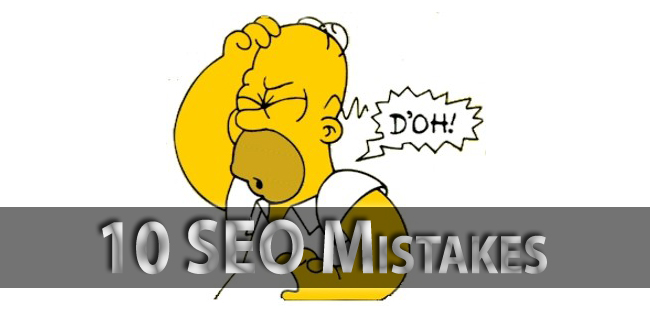
People are always asking me how I get so many views, comments and tweets on my blogs. They feel there must be some magic voodoo I chant over each post to have it do well. Or maybe I kneel down and do a Tebow prayer after each post. Many blogosphere beginners invest their precious time into hacking out a couple posts and then conclude that “blogging is just not worth the effort.” I’d hate for you to miss out on all the juicy leads and buzz you could be generating for your business, so I’m going to share 10 of the biggest SEO mistakes new bloggers make.
![]()
 First and foremost, you are absolutely wasting your time if you have no clue about keywords. These are the literary magnets that draw visitors to your post. Without focusing on keywords, you’re really living on a prayer that someone will find your blog on page 1,000 of the search results. Before you start your post, you need to hit up Google’s Keyword Tool. Look up words you would type into Google to search for your business or blog post. Choose one main keyword per post – ideally something with “low” or “medium” competition and more than 100,000 searches per month. Use this word about once per paragraph.
First and foremost, you are absolutely wasting your time if you have no clue about keywords. These are the literary magnets that draw visitors to your post. Without focusing on keywords, you’re really living on a prayer that someone will find your blog on page 1,000 of the search results. Before you start your post, you need to hit up Google’s Keyword Tool. Look up words you would type into Google to search for your business or blog post. Choose one main keyword per post – ideally something with “low” or “medium” competition and more than 100,000 searches per month. Use this word about once per paragraph.

![]() When it comes to search engine optimization, headlines matter a lot. You want to include your keyword in the headline, but you also want it to be a curiosity phrase that makes people want to know more. For instance, here I used “10 Biggest SEO Mistakes Bloggers Make” because it creates anticipation for a list. Using numbers always fares well with Google.
When it comes to search engine optimization, headlines matter a lot. You want to include your keyword in the headline, but you also want it to be a curiosity phrase that makes people want to know more. For instance, here I used “10 Biggest SEO Mistakes Bloggers Make” because it creates anticipation for a list. Using numbers always fares well with Google.
![]() Subheadings break up the content and make your blog post more enjoyable to read and easier to scan. Yet, there are also SEO benefits you don’t want to miss out on. Search engine bots are also lazy like people, and they scan headlines and subheadings for keywords first. Make sure to put your keyword into subheadings 1, 2, 3 and 4. HTML wise, all you need is <h1> at the start and </h1> at the end (for headline 1). It’s seriously that easy.
Subheadings break up the content and make your blog post more enjoyable to read and easier to scan. Yet, there are also SEO benefits you don’t want to miss out on. Search engine bots are also lazy like people, and they scan headlines and subheadings for keywords first. Make sure to put your keyword into subheadings 1, 2, 3 and 4. HTML wise, all you need is <h1> at the start and </h1> at the end (for headline 1). It’s seriously that easy.
![]() A post slug is what shows up in the URL. This is auto-generated for you based on your title… and it’s not always pretty.
A post slug is what shows up in the URL. This is auto-generated for you based on your title… and it’s not always pretty.
![]()
 Images make blog posts look great, but they can be so much more than just eye candy. Before uploading images to your site, name them after your keyword phrase. Then, after uploading, enter your keyword again under “alt text” and “title tag.” You may use your main keyword or also your secondary keywords. When people conduct a Google image search, they just might find your page that way too.
Images make blog posts look great, but they can be so much more than just eye candy. Before uploading images to your site, name them after your keyword phrase. Then, after uploading, enter your keyword again under “alt text” and “title tag.” You may use your main keyword or also your secondary keywords. When people conduct a Google image search, they just might find your page that way too.
![]()
 Some SEO blogging mistakes are missed opportunities. In Google-land, videos equate with quality content, so add them. Ideally, you’ll make your own unique content, upload it to YouTube, and include keywords in the tags. If that’s not feasible for you right now, you can look to existing videos on YouTube to embed.
Some SEO blogging mistakes are missed opportunities. In Google-land, videos equate with quality content, so add them. Ideally, you’ll make your own unique content, upload it to YouTube, and include keywords in the tags. If that’s not feasible for you right now, you can look to existing videos on YouTube to embed.
![]() Interlinking is a little trick bloggers use to get people to explore more of their sites. I like to mention other posts I’ve written (and link to them as well.) You should add at least two or three links to other related posts to keep search engine bots — and readers — on your site longer.
Interlinking is a little trick bloggers use to get people to explore more of their sites. I like to mention other posts I’ve written (and link to them as well.) You should add at least two or three links to other related posts to keep search engine bots — and readers — on your site longer.
![]()
 That may sound harsh, but you need to give love to receive it. Link to other bloggers and news sources to improve the authority of your site. Search engine bots see that you are an aggregator of relevant information, and that you are providing value and service to your readers by backing your claims. Relationship building is important in selling, and important in blogging too, so make friends with other bloggers and you just may be able to tap their readers too.
That may sound harsh, but you need to give love to receive it. Link to other bloggers and news sources to improve the authority of your site. Search engine bots see that you are an aggregator of relevant information, and that you are providing value and service to your readers by backing your claims. Relationship building is important in selling, and important in blogging too, so make friends with other bloggers and you just may be able to tap their readers too.
![]()
 The meta description isn’t your Aunt Edna who you need to rush past to avoid that fat, juicy, lipsticked good-bye kiss. You need to take a little time to summarize your article in 155 words or less with the most poignant sentence in the blog, as well as your main keyword. This paragraph will show up in Google and make people want to click your link – or not. It will also show up when you post the blog on social media sites.
The meta description isn’t your Aunt Edna who you need to rush past to avoid that fat, juicy, lipsticked good-bye kiss. You need to take a little time to summarize your article in 155 words or less with the most poignant sentence in the blog, as well as your main keyword. This paragraph will show up in Google and make people want to click your link – or not. It will also show up when you post the blog on social media sites.
![]() Your blog is there to inform, but let’s be honest… it’s also there to sell. You don’t want to cram your sales pitch down readers’ throats throughout the whole blog, but it’s tactful to include a line at the end, letting them know what you want them to do. For instance, you might ask them to share the post with friends, take a look at your sale products, comment on your post, or call you for more information.
Your blog is there to inform, but let’s be honest… it’s also there to sell. You don’t want to cram your sales pitch down readers’ throats throughout the whole blog, but it’s tactful to include a line at the end, letting them know what you want them to do. For instance, you might ask them to share the post with friends, take a look at your sale products, comment on your post, or call you for more information.
Hopefully you have a good idea of what you need to do to make your posts more searchable and Google-friendly. My last tidbit of advice is to take your time and make sure your posts are free from formatting and spelling errors. Hire an editor or professional blogger if you need to, but for heaven’s sake, polish that blog and make it worth reading. There is way too much garbage cluttering the internet as it is! People often ask me how long a blog post should be. As you can see, I’m not stingy with my words. The more words you have, the more opportunity you have to include keywords. Yet, not everyone is fond of reading, so throw a few short ones in there to mix it up a bit. Now go get em’, tiger!

Thanks, just reminding me of some things I need to take care on my own fitness blog.
-David Veras
Awesome tips on blogging, thanks!
Thanks for the tips, I definitely am making these mistakes!! lol
Kudos again on the helpful content Sam.